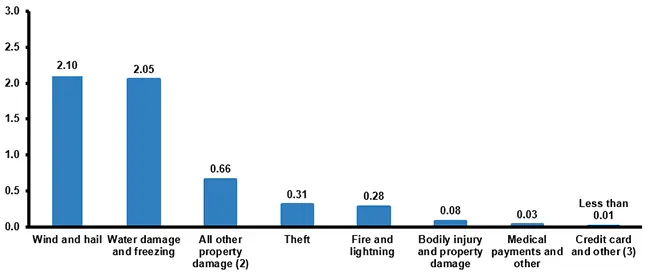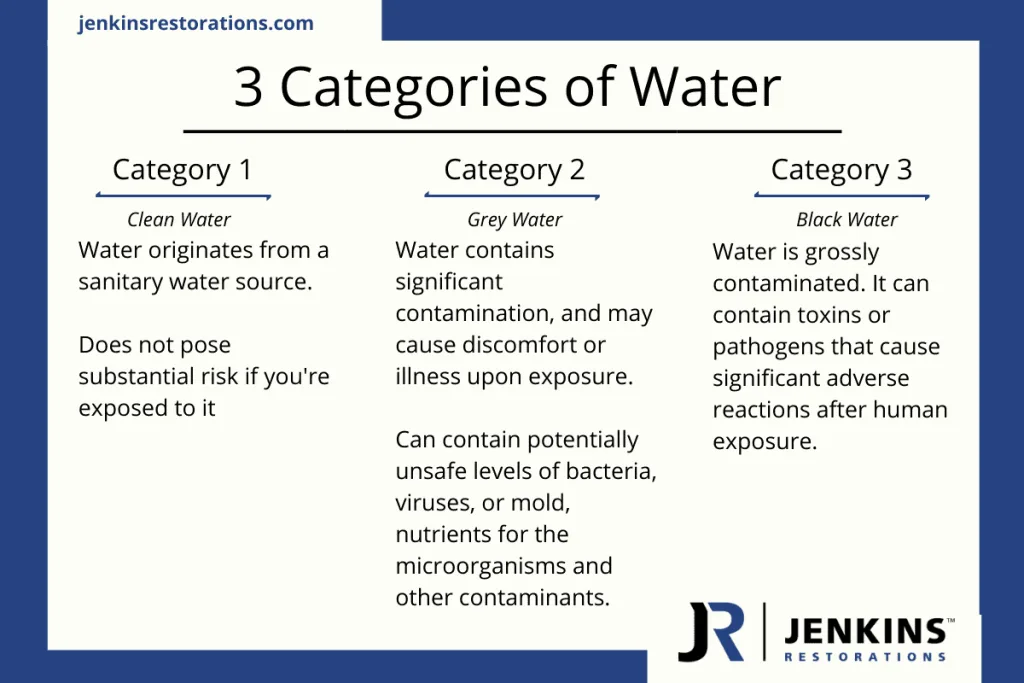The 3 Categories of Water Damage

Water is one of the most common causes of damage that can occur in a commercial or residential building. According to ISO (Insurance Services Office), water damage claims are the second most frequent insurance claim, following wind and hail damage. There are many things to look for when it comes to water damage. One of those things is the category of water damage.
What do you need to know about the different categories of water?
The different categories of water refer to the source of the water damage and other potential contaminants, including what the water may come in contact with. Water cleanliness plays a major role in the risk that the water poses to anyone or anything that comes in contact with it.
The IICRC water classification says the categories of water “refer to the range of contamination in water, considering both its originating source and its quality after it contacts materials present on the job site”. Although they are no longer official designations, many still refer to those categories as Clean, Grey, and Black Water. Those terms can be helpful when trying to remember the cleanliness level of each category.
Categories of Water Damage
The IICRC Standard for Professional Water Damage Restoration (IICRC S500) is a procedural standard that defines the 3 categories of water.
- Category 1 water damage: Sanitary “Clean Water”
- Category 2 water damage: Significantly Contaminated “Grey Water”
- Category 3 water damage: Grossly Contaminated “Black Water”
Knowing the definitions of categories and types of water damage situations can help you understand what you’ll be dealing with if you’re dealing with a similar incident.

Category 1 Water – Sanitary (“Clean Water”)
The IICRC S500 defines Category 1 water damage as water that “originates from a sanitary water source and does not pose a substantial risk from dermal, ingestion, or inhalation exposure.” Examples can include:
- Water supply lines
- Melting ice/snow
- Rainwater
- Toilet tanks
- Toilet bowls without contaminants
Category 1 Water Damage
The keywords here are “sanitary water source” and “does not pose a substantial risk”. That is why this water is considered “clean”. It is also why a restoration contractor like Jenkins Restorations can theoretically salvage and dry any affected building material. Wet drywall, carpet, pad, hardwood flooring, and more can and are oftentimes dried and salvaged on Category 1 water damage incidents.
Category 2 Water – Significantly Contaminated (“Grey Water”)
The IICRC S500 defines Category 2 water damage incidents as water that “contains significant contamination and has the potential to cause discomfort or sickness if contacted or consumed by humans.” Examples can include:
- Dishwasher/washing machine discharge or overflow
- Toilet bowl overflow with urine
- Hydrostatic pressure seepage (commonly occurs in basements or slabs)
- Broken aquariums
- Punctured water beds
Category 2 Water Damage
Category 2 water loss contain significantly contaminated water. Make sure your restoration contractor removes wet carpet padding and disinfects affected materials like carpeting. Jenkins Restorations uses an anti-microbial spray and HEPA vacuuming to disinfect affected materials after category 2 water damage incidents.
Category 3 Water – Grossly Contaminated (“Black Water”)
The IICRC S500 defines Category 3 water damage as water that is “grossly contaminated and can contain pathogenic, toxigenic, or other harmful agents and can cause significant adverse reactions to humans if contacted or consumed.” Examples of Category 3 water damage can include:
- Sewage
- Waste line backflows originating from beyond the trap
- Seawater
- Rising water from rivers/streams
- Wind-driven rain from hurricanes/tropical storms
Category 3 Water Damage
Category 3 water loss contain grossly contaminated water. Your restoration company contractor should remove all affected cosmetic materials such as insulation, hardwood flooring, drywall, carpet padding, carpet, and cushions. Jenkins Restorations uses an anti-microbial spray and HEPA vacuuming to disinfect affected items after category 3 water damage incidents.

Specialty Drying Situations
Certain materials such as plaster, brick, or concrete, require special drying methods even if the water damage is at a Category 1 or 2. This primarily occurs when there’s a large volume of water to these materials.
What Types of Water Damage Does Homeowners Insurance Cover?
Most home owners insurance policies will cover water damage if it is sudden and accidently. Examples of this would be damage caused by rain, snow, or frozen pipes. However, some types of water damage may be excluded from coverage, such as water damage resulting from seepage or faulty plumbing.
Category Deterioration
It’s important to be aware that Category 1 water loss can deteriorate into Category 2 or 3 water. This can happen when category 1 water comes in contact with microorganisms such as mold or the water is left in affected items for over 24 – 48 hours. Often you’ll notice this by odors in the damp material.
If you experience water damage in your home or commercial property, call Jenkins Restorations at 888.450.6580. Let our team of professionals assess and repair your water damage so that you and the occupants of your building or home stay safe.
References
- According to ISO, water damage claims are the second largest frequent insurance claim, following wind and hail damage
- IICRC S500
Frequently Asked Questions
Is rain water category 3?
The rain itself isn’t Category 3 water. Rainwater is mostly evaporated water that comes from a variety of sources such as lakes, rivers, and oceans. According to IICRC S500, atmospheric rain water is defined as Category 1. 1
Is fire sprinkler water category 3?
When it comes to grading the category of a loss for sprinkler water, it is very situational. For example an new building with CPVC piping setup as dry system will probably be a category 1 water damage; whereas older black iron pipe systems could fall into Category 3 if the water it’s carrying is contaminated.
What category is ground water?
Groundwater is classified as category 3 water, and is not a source of drinking water.
